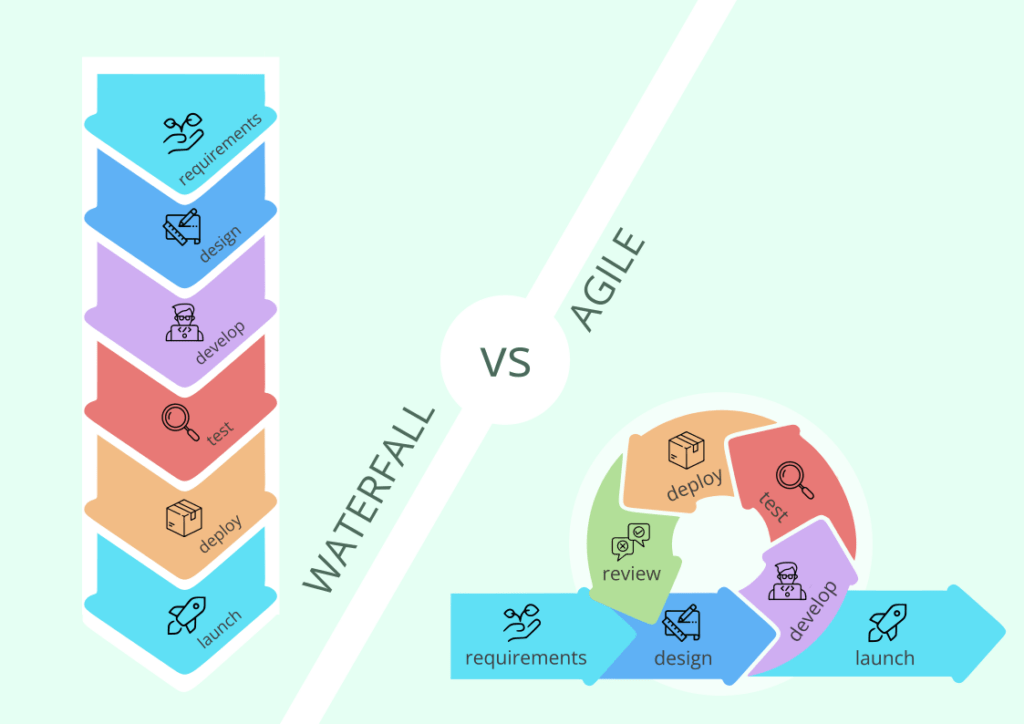HOW CAN IT BENEFIT YOUR COMPANY?
In today’s business landscape, change is a constant element. Companies that want to keep up with the times and stay competitive, have to adopt more agile approaches to software development. Agile methodologies are a set of principles and practices that enable quick adaptation to customer demands, market changes, and technological advancements. This adaptability allows businesses to seize new opportunities and effectively mitigate risks, ensuring personal growth and success.
WHAT IS THE MAIN PURPOSE?
Agile methodology is a development approach based on principles such as flexibility, collaboration, and continuous value delivery. The main objective of Agile methodology is to quickly and effectively respond to changes in project requirements and customer needs. It focuses on efficiently creating high-quality products with an emphasis on customer satisfaction. It is an alternative to traditional Waterfall development models, which complete project phases sequentially and with little flexibility.
Agile is not defined by a series of specific development ceremonies or techniques. Instead, it’s a group of methodologies that focus on tight feedback loops and continuous improvement. When discussing Agile, it is essential to mention the Manifesto for Agile Software Development which emphasizes its key principles. The first one is to prioritize people, their individuality, and their interactions, rather than focusing solely on processes and tools.

SCRUM: AN EXAMPLE OF AGILE METHODOLOGY
One of the most well-known examples of Agile methodology is Scrum. Scrum is a framework that organizes work into defined time units called “sprints,” usually taking 2-4 weeks. During a sprint, the team collaborates on a specific set of tasks known as the Sprint Backlog. In Scrum, there are three key roles: the Product Owner, the Development Team, and the Scrum Master. These roles work together to ensure the successful implementation of the Scrum framework and the delivery of high-quality products.
- The Product Owner represents the needs of the customers and the business
- The Development Team is responsible for doing the work
- The Scrum Master supports the Scrum process by removing obstacles and promoting collaboration
WHAT ARE THE REAL BENEFITS FOR CUSTOMERS?
Adopting an Agile methodology offers numerous advantages to customers seeking successful project completion and more effective satisfaction of their needs. Here are some of the key benefits that customers can expect from Agile:
Faster Delivery
Agile development enables faster delivery of products and services, promoting a quicker time-to-market and maximizing product lifecycle. Customers can see a positive impact on new features or improvements much earlier compared to traditional development models that may take months or years to deliver a complete product.
Active Involvement
Agile promotes active customer involvement in the development process. Customers are encouraged to participate in reviews, provide constant feedback, and engage in project planning sessions. This ongoing and direct involvement ensures that the developed product aligns with customer expectations, increasing overall satisfaction and minimizing the risk of creating an unused product. By putting customers first and delivering exceptional experiences, companies can foster long-term loyalty and trust.
Flexibility and Adaptability
Requirements may change and customers may have new ideas during development. Agile allows quick adaptation to such changes without significant disruptions to the process. Being able to anticipate and meet the changing needs of customers is a competitive advantage in today’s ever-changing business landscape.
Continuous Improvement
Quality is at the heart of Agile, with a focus on constant testing and validation. Developers work closely with customers to ensure the product meets the required quality standards. Constant testing and validation drive improvement, enable experimentation with new ideas, and facilitate the implementation of changes throughout the software development cycle, ensuring a high-quality final product.
Risk Reduction
Agile development uses iterative, feedback-driven processes that help catch risks sooner and ensure that the final product meets customer requirements. This reduces the time and cost of fixing errors and results in fewer, cheaper mistakes.

IS AGILE ALWAYS THE ANSWER?
As observed up to this point, implementing agile methodology in an organization can bring numerous benefits, such as increased flexibility, improved communication, and faster delivery of products or services. However, there are also some situations in which adopting this methodology may not be the most appropriate choice and there are potential drawbacks and challenges to consider. Among others, we can mention:
Ineffective Planning and Execution
Ineffective planning and execution can lead to delays and inefficiencies. Having a clear understanding of project goals, timelines, and milestones is essential for effective planning and execution, as it helps team members stay focused, prioritize tasks, and track progress towards the overall project success.
Unready Organizational Culture
When a team is resistant to change, it can have various negative impacts on the implementation of new processes, technologies, or strategies, which can ultimately lead to delays in project completion. Fostering collaboration, open communication, flexibility and providing team members with the freedom to explore new ideas are essential strategies for cultivating a culture of continuous improvement.
Lack of Stakeholder Involvement
When stakeholders are not fully engaged, conflicts and delays in project execution can happen. Educating stakeholders on the benefits of Agile and involving them in the early stages of the project can help address challenges related to their engagement.
Unclear Goals and Priorities
Agile methodologies, while effective in enabling teams to adapt to changing circumstances and emerging requirements efficiently, can also expose them to risks. One of these risks is the potential for goals and priorities to become unclear, which can lead to confusion and miscommunication within the team, ultimately impeding progress and hindering the team’s ability to deliver value effectively.
Insufficient Resources
When the team is faced with a lack of resources, they may become overloaded with work, which can negatively impact their efficiency. It’s essential to ensure that all the required resources, including team members, appropriate tools and a supportive organizational culture are provided in order to avoid burnout and enhance productivity.
INDIVIDUALS AND INTERACTIONS OVER PROCESSES AND TOOLS
Transitioning to an Agile methodology involves a shift in how we approach projects and tasks. We redefine our way of working and move away from traditional, sequential methods embracing a more iterative and collaborative approach that allows us to deliver value more quickly and effectively. As we mentioned in the beginning, the first value in the Agile Manifesto is “Individuals and interactions over processes and tools”. In other words: people drive the development process and respond to business needs. By promoting a culture of collaboration, continuous improvement, and adaptability, we’re able to empower each individual to contribute with their unique talents and perspectives. By applying Agile principles and practices, companies can create an environment where innovation thrives, and customer needs are met.
Working in an Agile team is not just a destination, but a mindset that keeps us responsive, adaptable, and focused on delivering value.
Main Author: Cristian Bertuccioli, Scrum Master Certified e Senior Software Engineer @ Bitrock

